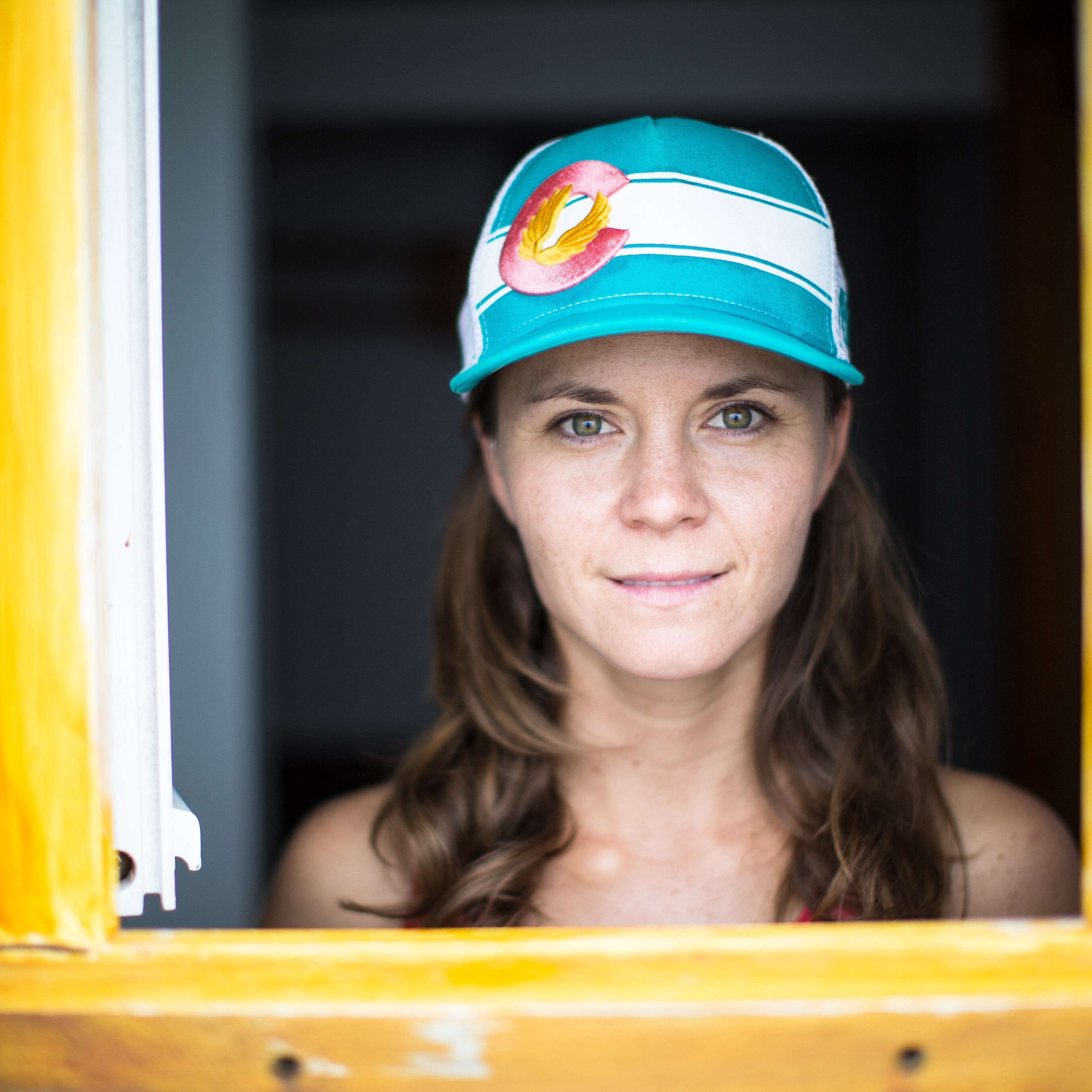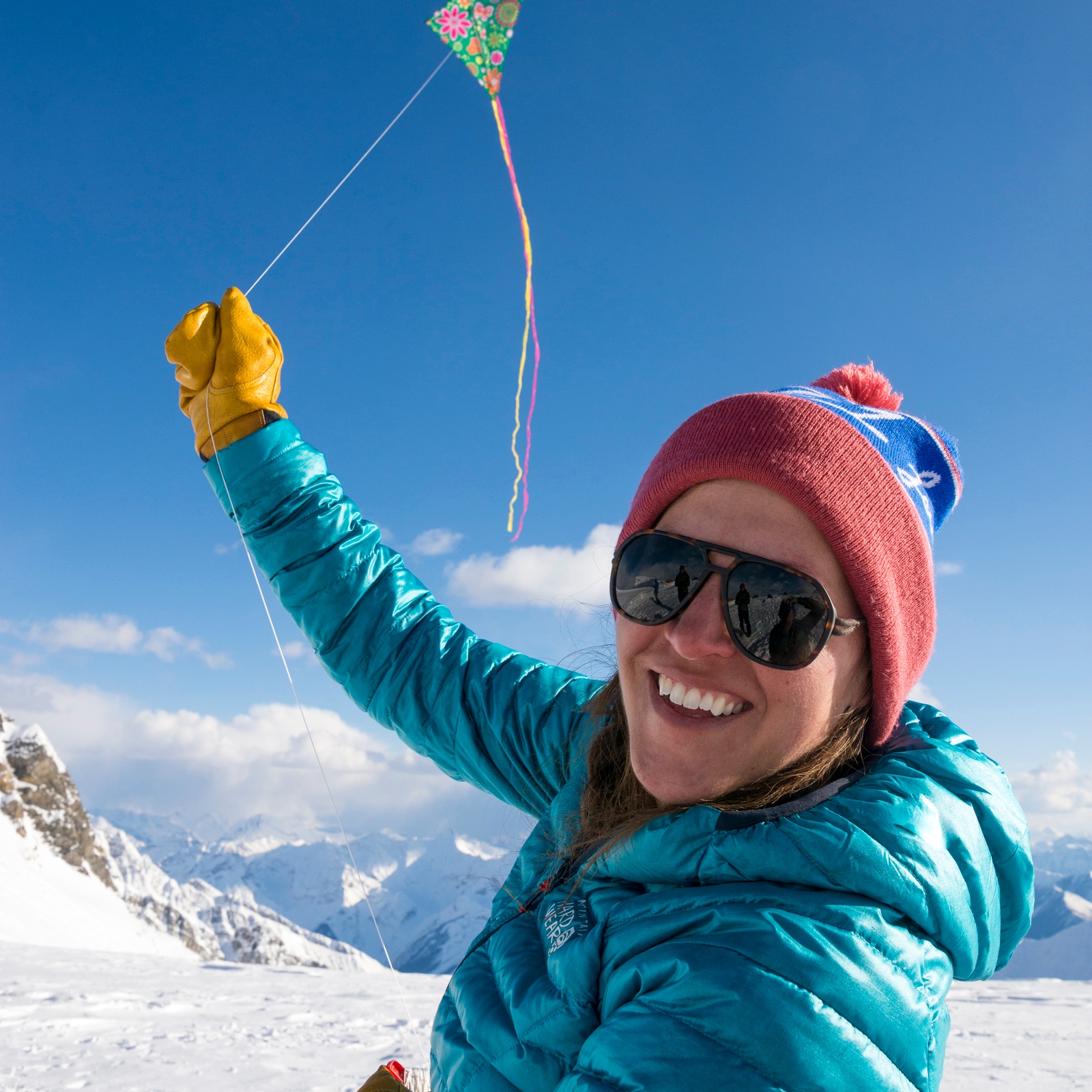There was a time when sandals were reserved for the beach or the public shower. Blessedly, those days are long gone. Outdoor-oriented companies have taken the same core DNA of your standard flip-flops and leveled it up with features like a beefier sole, more secure webbing, greater arch support or some combination of all three. All that adds up to a sandal that's just as at home on the trail as it is the pool—but which is best for you?
We enlisted the feet of 34 testers across the country to put this year's top hiking sandals through their paces. Our testers scaled peaks, crossed rivers and suffered more than a few blisters to bring you the 6 best technical sandals available at REI.
The 6 Best Hiking Sandals of 2025: Test Results
Find our quick recommendations here or read on for the full breakdown of our field test of the best hiking sandals.
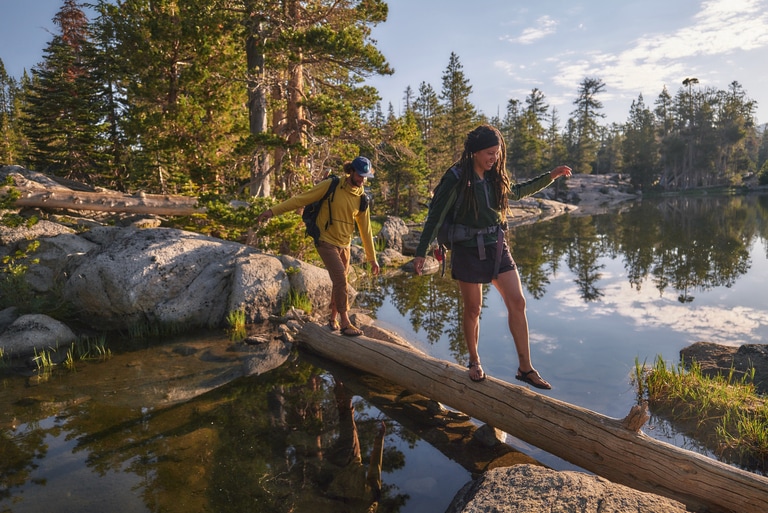
Best Overall Hiking Sandal & Editor’s Choice Award Winner
Bedrock Sandals Cairn Evo Sandals
Score 97
Upper Polyester and nylon straps
Midsole EVA
Outsole Rubber
Weight (pair) 15.6 oz. (Evo), 1 lb. 1.4 oz. (Evo 3D), 1 lb. 3.4 oz. (Evo C)
Best for Backpacking, hiking, watersports
“These are my dream hiking sandals!” That’s exactly what our testers said after putting their Cairn Evo Hiking Sandals from Montana sandal-maker Bedrock to the test. We sent out pairs of the Cairn Evo, Cairn Evo 3D and Cairn Evo C, and the feedback was universal: Where have these shoes been all our outdoor lives? They scored the highest marks where it counts most for trail shoes: comfort and support, traction, and durability.
Despite their relatively flat, minimalist footbed, even testers with chronic foot pain or injuries found them exceptionally forgiving. Our Michigan tester compares the Evo 3D's softer, more flexible footbed with other brands’ saying, “I can’t believe how comfortable these sandals are!” (Note: The primary difference among the three versions is footbed cushiness and, subsequently, weight; structurally, the unisex Cairn Evo, Cairn Evo 3D and Cairn Evo C are identical.) The same tester noted it took her a few days to break in the toe straps (and she found she preferred to wear split-toe socks for extra comfort), while other testers were surprised how easy they were to wear right out of the box. “I was also nervous about the Y-strap because I've historically gotten wicked blisters from shoes like that, but these didn't even whisper at a hot spot,” another says.
Grippy Vibram® nonmarking outsoles help these stay put wherever you place them. Testers took them on trail runs, dog walks, dry hikes on dirt trails, wet hikes on gravel and grass, rocky water crossings, kayaking trips, even climbing. Out of all of these outings, just one slip-up was reported while trying to cross over a fallen tree. Bonus: They’re eligible for resoling through the Bedrock Re-Soul & Repair program. With three adjustment point—including the Velcro® heel strap—testers found these provided a snug and customizable fit. Our California tester says, “These are the first pair of sandals that I’ve hiked in that felt like a supportive hiking shoe/boot.”
Perhaps the feedback that matters the most? When a tester loves their shoes so much, they have to share them immediately: “I am such a fan of the Bedrock Cairn Evo 3Ds I bought my sister a pair. (I also ordered more of the split-toe socks.)” Buy Cairn Evo Sandals. Buy Cairn Evo 3D Sandals. Buy Carin Evo C Sandals.
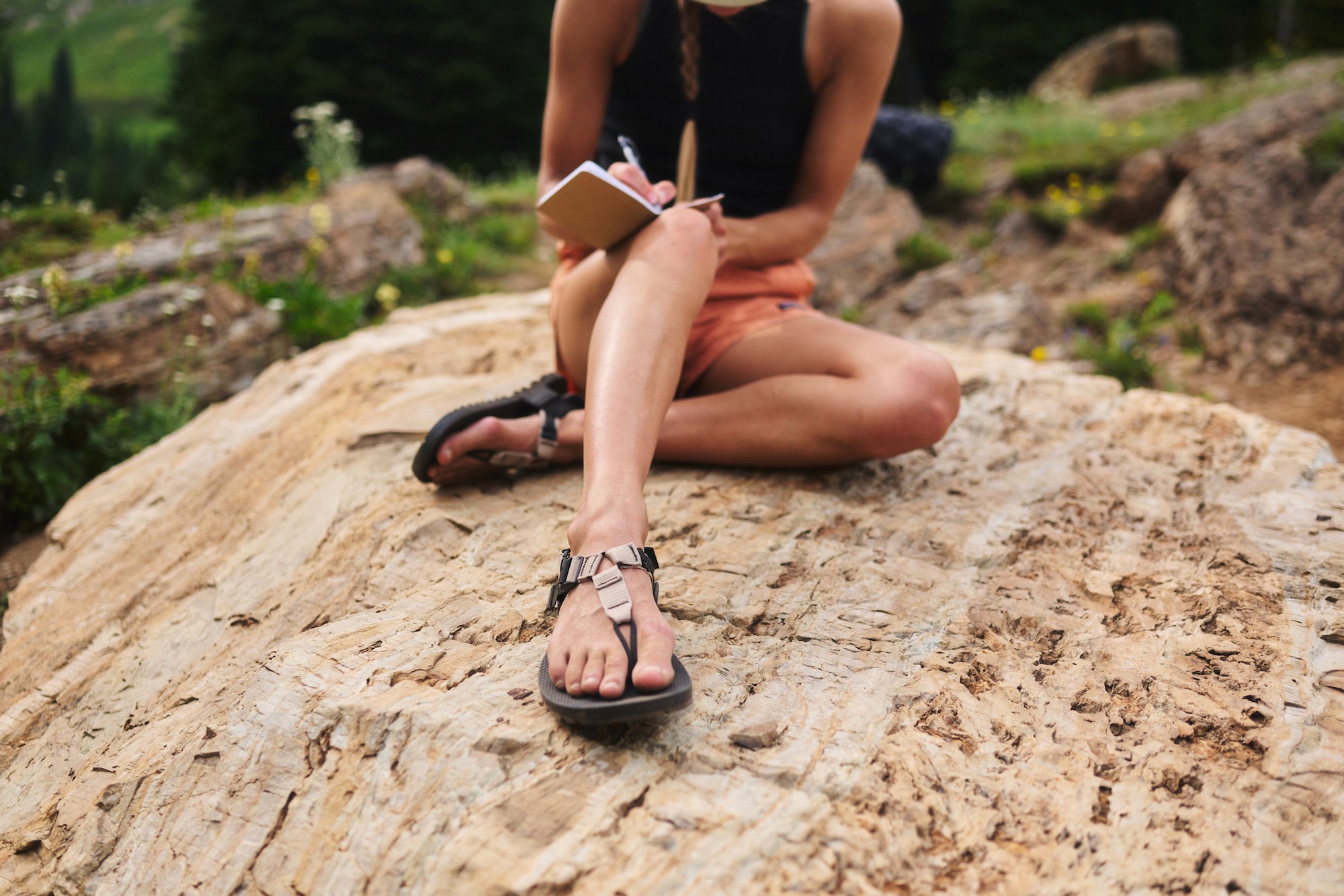
Bottom Line: When you need a hiking sandal with the soul (and soles) of a boot, strap into a pair of remarkably comfortable, supportive Bedrock Evo Sandals—no matter the adventure.
Testing Stats:
- Total miles: 150
- Testing states: California, Michigan, Minnesota
- Best testing story: Our Michigan tester reports, “As a result of running marathons and ultras for decades, I have a lot of wear and tear, arthritis, swelling and pain in my joints. I packed my trail runners thinking I would have to switch up when my feet start hurting while wearing the sandals. I was shocked to realize they were so comfy I forgot I was wearing them. I eventually stopped packing my trail runners.”


Teva Terra Fi 5 Universal Sandals
Score 94
Upper REPREVE® recycled polyester
Midsole Polyurethane
Outsole Rubber
Weight (pair) 1 lb. 4 oz. (women's), 1 lb. 10 oz. (men's)
Best for Hiking, multisport
It's rare for testers to unanimously agree on anything, so we took note when they all praised the Teva Terra Fi's unmatched comfort. "These sandals cradle my foot like it's a baby," one said. "I felt like I was walking on memory foam," said another. The secret: lots of cushioning. It starts with a soft molded polyurethane (PU) midsole that's, well, foot-shaped. With contours that accomodate the heel and ball of the foot, plus the arch, the Terra Fi feels great out of the box. The leather version even has a delightfully plush footbed. But it doesn't end there. Teva lines each of the strap posts with cushy EVA foam—a pillow-like barrier against any friction.
Three adjustable hook-and-loop straps (one each at the forefoot, instep and heel) move well and conform to a variety of foot shapes. Quick adjustments are no problem, should you want to ratchet the straps down for hiking or loosen them for more casual wear. One tester noted that the Terra Fi was just as comfortable at the end of a long travel day, after his feet had swelled.
The Terra Fi has a TPU shank inside the PU midsole, which offers up more support than the majority of sandals in the test. We felt solid under loads up to 40 pounds and even when hefting our tired kiddos. Teva places its most versatile rubber compound on the outsole, so it holds fast to dry rock and dirt. The flatter pattern on the bottom of the shoe isn't suited well for mud or slick terrain, however. (Also, though the water-friendly leather holds up OK in wet conditions, we'd recommend the synthetic version of this sandal for folks who plan on frequenting sloppy and sloshy trails; it dries faster.)
"I call these my do-it-all sandals," says one Colorado-based tester. "I travel in them, do everyday chores in them, hike in them and even wear them to the office." (Editor's note: This is Boulder we're talking about.) "They're my daily drivers." That's versatility we can all get behind. Trade-off: The aesthetics aren't for everyone. Buy women's. Buy men's.
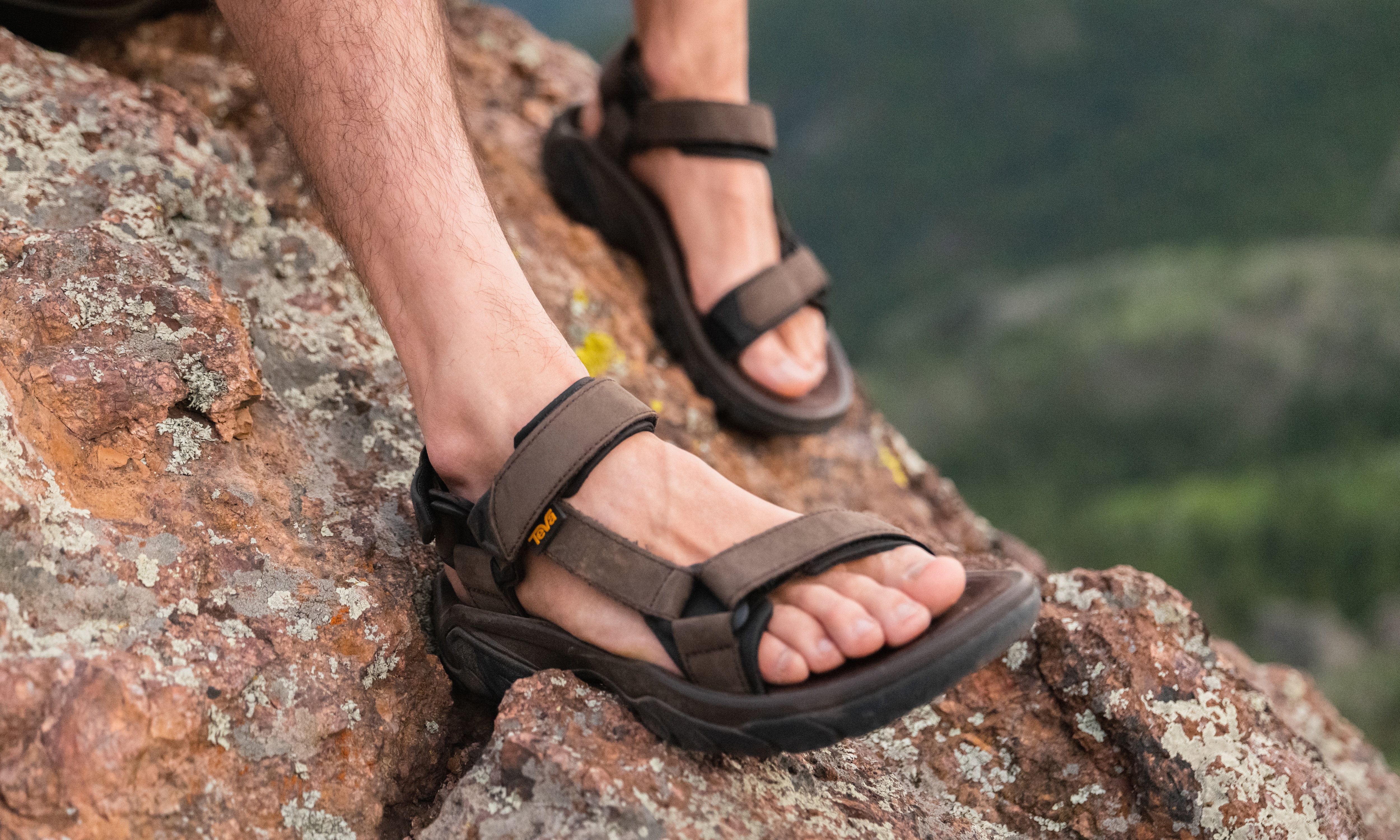
Bottom Line: Out-of-the-box comfort and a firm, supportive midsole lend the Teva Terra Fi 5 to everything from multisport to everyday wear.
Testing Stats:
- Total mileage: 58 (54 on trail, 4 in water)
- Testing states: California, Colorado, Texas
- Vertical gain: 8,200 feet
KEEN Hyperport H2 Sandals
Score 82
Upper Polyester webbing
Midsole Injected EVA
Outsole Aquagrip rubber
Weight (pair) 1 lb. 3 oz. (women’s) 1 lb. 8.3 oz. (men’s)
Best for Hiking, watersports
Puddle jumping, canoeing, kayaking, rainforest hikes, waterfall chasing and even rainy-day dog walks are no match for the super lightweight and supportive Hyperport H2 Sandals from Keen.
“These sandals are legit,” says one lake-loving tester from Minnesota, who wore them hiking, wading, canoeing and exercising her dog. “I love the rubber toe bumper for extra protection for my feet out on the trail, in water, or in my boat. You never know when you're going to hit a rock or stub your toe so it's super that these are so rubbery. There aren’t many sandals I’d feel confident in waring for bike riding, hiking, watersports or beachcombing besides these.”
Injected EVA foam midsoles provide lightweight spring for your step while cradling your foot so comfortably that it’s “like walking with pillows strapped to your feet,” one tester says. A generous toe box allows toes to splay comfortably, which can increase balance and stability on
uneven surfaces. You’ll feel like you have grippy webbed feet with the nonmarking rubber outsoles, which are designed to hold tight to wet rock and other damn surfaces. Multidirectional lugs bump up the traction, so you can even stroll through mud with confidence.
The mesh uppers felt comfortably snug for our testers, and cinchable bungee laces let you adjust the fit based on your activity: Wear them tighter for more active pursuits, or loosen them up for a more casual, slip-on-like feel. Nonfluorinated durable water repellent (DWR) coating helps liquid bead right off the polyester material. Several testers expressed surprise at how easy the uppers were on their skin: “I'm honestly shocked that I haven't gotten any blisters, considering how many potential hot spots there are,” says one hiker who reports that they always suffer from friction points at the ankle and along their first and fifth metatarsals.
Caveat: one tester who wore these on a hike on Washington’s Bainbridge Island said they felt like they were wearing sneakers without socks and developed blisters on their heels even after breaking in the Hyperport H2s first. With socks, however, that tester reported no flare-ups and says they felt as comfortable as a wider running shoe. “I felt as supported as I would in the Altras I hike in,” they said, adding that it’s “the most support I’ve ever felt in a sandal.” Buy women’s. Buy men’s.
Bottom Line: Whether it’s a trail crossing, multiple portages or a casual paddle on the lake, the Keen Hyperport H2 Sandals are like a lifejacket for your feet if you’re planning on tackling water.
Testing Stats:
- Total miles: 50
- Testing states: Minnesota, Washington
- Best testing story: One tester found a dual purpose for their Hyperports while on a summer paddling trip: water-bottle holder. “When I was in my canoe, I could take them off and wait for them to dry and use them to keep my water bottle from rolling around. I just stuck it upright in the opening adjusted the tightness. Since most sandals don't have fabric like this, they couldn't support your water bottle in this way and keep it so it doesn't tip or roll around and within reach so you can hydrate easily. Well done, Keen.”


Chaco Mega Z/Cloud Sandals
Score 88
Upper 28 mm polyester jacquard webbing
Midsole LUVSEAT™ polyurethane
Outsole ChacoGrip rubber
Weight (pair) 1 lb. 5.4 oz. (women’s) 1 lb. 10.6 oz. (men’s)
Best for Multisport, water crossing, watersports
When you’re looking for the ultimate comfort in a hiking sandal, wear the same kicks as your favorite camp counselors: strappy, secure and stylish Mega Z/Cloud sandals from Chaco. The classic, vegan-friendly 360-degree jacquard webbing straps with cozy-yet-nonrestrictive toe loop are perfect for lounging at a picnic lunch, sprinting for an errant disc or scrambling over trail-blocking boulders. Adjusting Chaco straps is notoriously divisive, but one California tester assures it’s worth the work: “Once you set up the straps to your size and liking, it’s very easy to strap in and always get the comfortable fit—but the process of threading the strap can be tedious.” Toe-strap haters rejoice: The Mega Z/Cloud design eschews the divisive Chaco toe strap while still offering a snug wrap overfoot.
Contoured proprietary footbeds made from durable polyurethane compounds resist breaking down and compressing after long use. One tester suffers from a neuroma in their left foot and needs to be especially careful with picking footwear. They found the Chacos to be supportive and springy: “If I didn't look down, I'd think I was wearing trail runners!” They wore their Mega Z/Clouds on several day hikes through Pennsylvania state parks and felt supported on a wide variety of terrain. “My testing included pretty solid inclines and declines and the Chacos provided impeccable traction, giving me peace of mind as I trekked. More impressive was how they handled on very rocky terrain in the Boulder Field at Hickory Run State Park,” they said. “I was walking across boulders as far as the eye could see and I never once lost faith in these sandals' ability to keep me upright and stable.”
Nonmarking proprietary rubber outsoles feature deep and grippy 3 mm lugs for outstanding traction on dirt, gravel, rocks and pavement—and they comprise 25% recycled rubber. In California, our tide-pool-exploring tester says the thick, durable treads have just enough weight to feel like they could handle wear and tear caused by sandy beaches, wet rock and salt water. “I would feel safe wearing these shoes in precipitation and technical terrain,” they said. Of course we love a sandal that’s made to last, and the Mega Z/Clouds are eligible for resoling at the brand’s factory in Michigan, through the ReChaco program. Buy women’s. Buy men’s.
Bottom Line: Built for long-lasting comfort on dry land and in water, Chaco Mega Z/Cloud Sandals offer a classic silhouette and unbeatable underfoot support.
Testing Stats:
- Total miles: 53
- Testing states: California, Pennsylvania
- Best testing story: “When I was on my first hike in these sandals, I crossed paths with two hikers who were also wearing sandals; one of them was wearing a similar pair of Chacos sandals. I didn't want to seem too corny and say, ‘Hey, nice kicks,’ but we each looked at each other's feet, made eye contact and knew we were kindred spirits.”
Xero Shoes Z-Trail EV Sandals
Score 85
Upper Polyester
Midsole TrailFoam
Outsole FeelLite rubber
Weight (pair) 8.6 oz. (women's 7), 10.8 oz. (men's 9)
Best for Ultralight hiking, barefoot-shoe users
With roughly 75% less weight and material than standard sport sandals, these minimalist, open-toe sandals are ideal for gram counters and folks who have a hankering for zero-drop or barefoot shoes.
Despite their incredible thinness, the Z-Trails’ foam midsoles and footbeds allow your feet to respond more naturally and instantly with ground surfaces while also providing a comfortable underfoot layer of protection. Gentle heel cups encourage stable foot placement and block some debris, but one tester found that they had a hard time keeping out smaller twigs and pebbles and would prefer to walk on grass in them. “No matter how tightly I cinched the straps, this made every hike an exercise in frustration between my foot and the debris on the trail,” they say.
The upper webbing is made from recycled plastic water bottles and provides soft but snug support on the top of your foot. Multiple adjustment points mean you can customize the perfect fit. One tester raved at how well these worked in a variety of environments (including beach, dirt trails, concrete and grass), but found the straps uncomfortable as their feet swelled with activity. “The straps are stiff, so it was hard to adjust perfectly, and I had to keep fussing with them throughout the day. As a result, my foot slid forward as I walk so my toes start to dangle off the front.” Other testers found that when they got the straps dialed in, the fit was extremely comfortable and true to size even over long days on trail.
One tester reported, “Best overall grip of the sandals I tested! This was partially due to the strength of the tread and lugs on the sole but also the security of the straps around all parts of my foot including the toe, ankle and heel, which drastically improved traction results,” after three long day hikes in Washington state. Flexible soles contribute to the sandals’ barely-there feel; If it weren’t for the traction provided by dual-chevron-treaded rubber soles, you might forget you were wearing them. And when you’re not? Roll ‘em up and stick ‘em in a pocket: They pack down about the size of a softball.
You might not be able to walk on water, but your Z-Trail EVs can. They float and are fully water-resistant, making them perfect as a lightweight shoe for paddleboarding or other watersports, or as protection against rocky lake or ocean bottoms. Some testers love the minimal barrier between foot and floor, while others said they would opt for burlier footwear on more technical hikes. “I do plan on using these as my camp shoes, though,” said one tester. “They are so light and serve that purpose really well. (Note that transitioning to barefoot and zero-drop shoes should be done gradually to avoid injury. Related reading: Minimalist/Barefoot Running Basics) Buy women’s. Buy men’s.
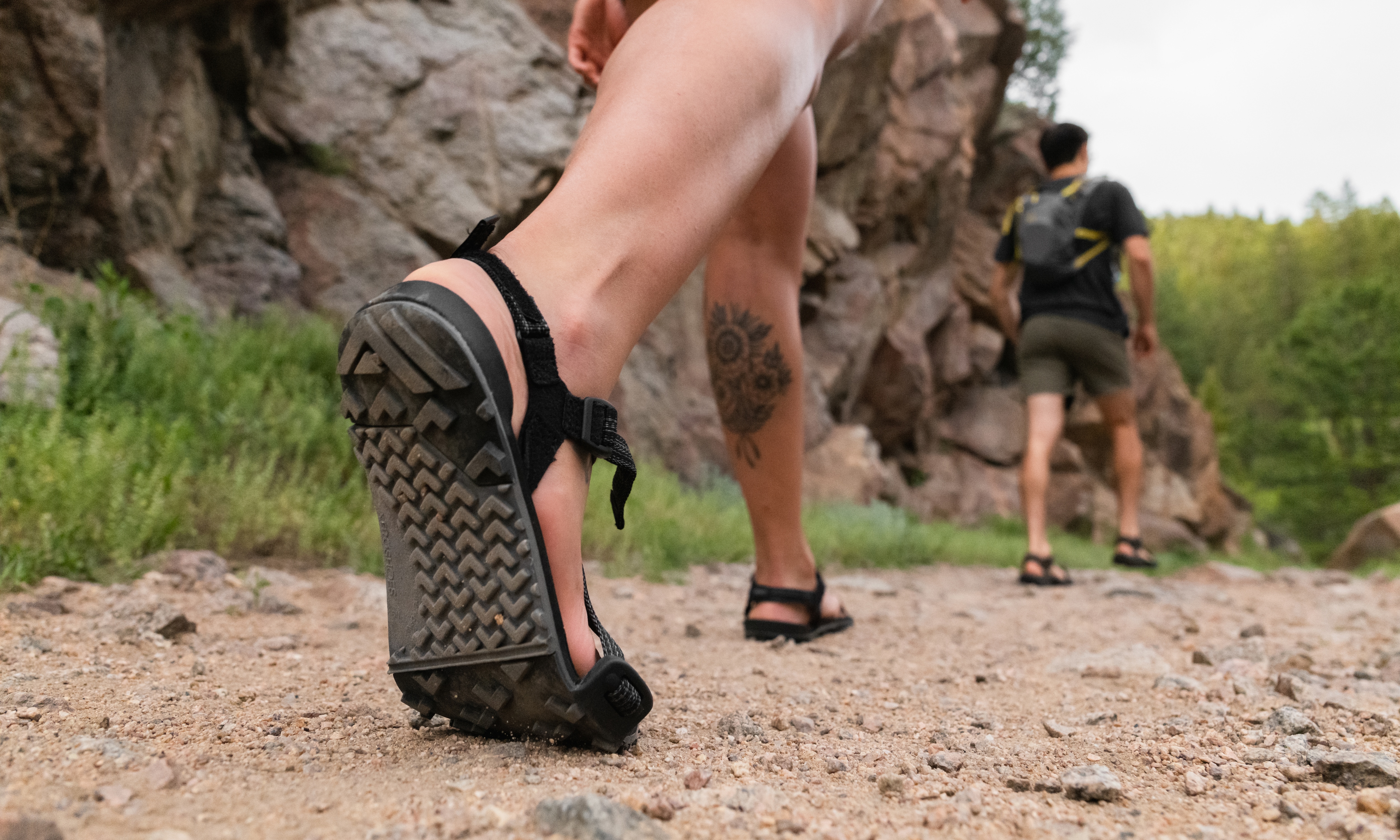
Bottom Line: Ultralight, ultrathin zero-drop hiking sandals aren’t for everyone, but Xero Shoes Z-Trail EV Sandals offer a natural gait and breezy almost-barefoot freedom you’re seeking from a minimalist shoe.
Testing Stats:
- Total miles: 55
- Testing states: California, Washington
- Best testing story: One tester relived their love of barefoot childhood summers by wearing their Z-Trail EVs to the park for lawn games with friends. Red Rover, Red Rover…
Birkenstock Arizona Rugged Sandals
Score 86
Upper Oiled leather
Midsole Cork/latex
Outsole Polyurethane
Best for Day hiking, urban hiking, everyday wear
When many people imagine sandals, the classic double-strapped, open-toe profile of Birkenstock come to mind. The Arizona Rugged is a sportier sibling to the iconic slides that have been part of the “crunchy” wardrobe since 1973, and we put them through their paces with treks on steep dirt trails, flat gravel paths, rolling technical terrain, wet grass—even hardwood floors. (Shh, don’t tell mom we wore shoes in the house.)
Durable oiled nubuck leather upper straps allow wearers to tighten the top grip for faster action or loosen them for a sandal that feels more like a burly slipper. Many testers loved the less restrictive straps and appreciated not having a contact point at the blister-prone heel, while others found it harder to get accustomed to the slides and longed for a toe or back strap. “Even though there still wasn't a heel strap, the heel cup on these felt more secure and that added to my comfort both physically and psychologically,” says one tester who tried several different sandals on trail.
Of course, no sandals would be Birkenstocks without a molded cork-latex footbed, which wears in to be as soft as any foam. But the wearing-in part is key: These sandals are not the slip-on-and-go type straight out of the box but will gradually welcome your foot shape over the course of repeated use. “Once you get past those first few weeks of wearing them indoors and letting them mold to your foot, I don’t think you’ll ever break up with them,” assures one Minnesota tester. (They recommend wearing them with light socks at first to prevent blisters in those early days—also an iconic look.)
Durable direct-injection polyurethane soles are light and flexible, but they don’t mess around when it comes to traction. “The grip on the sole was more assertive than I’m used to with regular athletic shoes, so I did have to get accustomed to a slightly tackier grip on the ground,” says one tester who wore them on wooded hikes in Washington state. “I found the added grip on the sole really helpful—there seemed to be more flex in this shoe, which gave it an edge on rocky, more technical terrain where a less flexible shoe can be a nuisance.” Unfortunately, none of our testers tried playing footbag while wearing Arizona Ruggeds, so you’ll have to report back about that field test on your own. Buy women’s. Buy men’s.
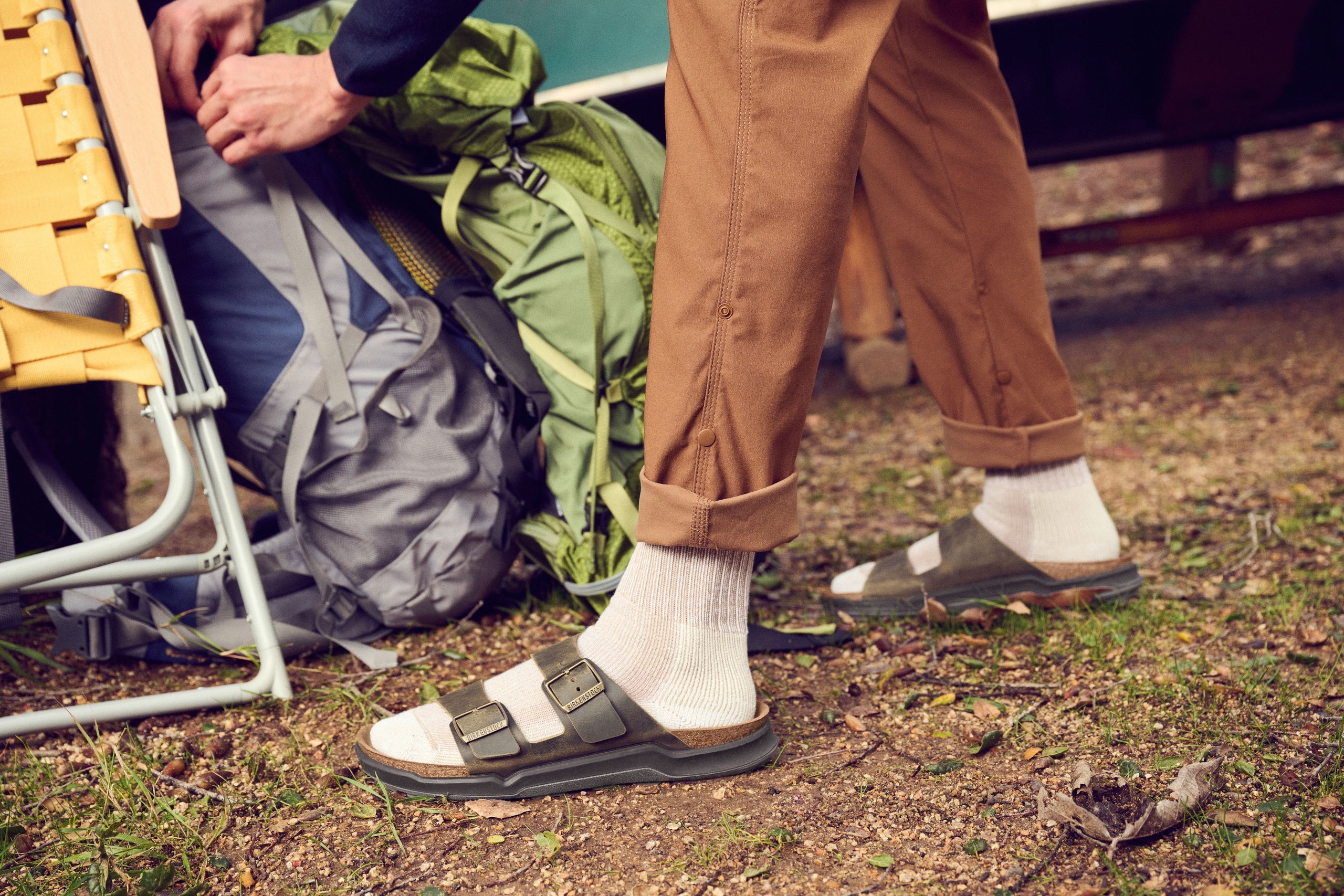
Bottom Line: When you want a classic sandal that's just as happy at the trailhead as at the post office, you can't beat the laidback, moldes-to-your-feet support of a pair of Birkenstock Arizona Rugged Sandals.
Testing Stats:
- Total miles: 74
- Testing states: Minnesota, Washington
- Best testing story: One tester wore their Arizona Rugged sandals out to meet up with a friend for a walk around a lake. “When I showed up, my friend said, "I was just talking with someone about whether or not Birkenstocks are inherently hippie shoes. I always thought of them as having a very Vermont, canvas-bag toting, independent-bookstore-shopping, have a kombucha mother on the counter kind of a vibe.’ I said, ‘Thanks, that’s exactly what I’m going for, actually!’"
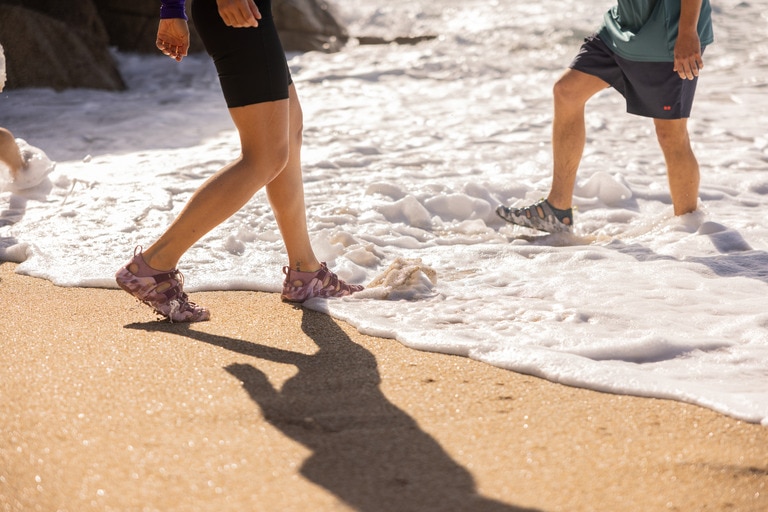
Buying Advice
In general, hiking sandals are open, often-airier shoes that enable you to hit the trail sans socks. But depending on your preferred type of trail time, you may opt for different features.
Traditional hiking and backpacking sandals boast firmer outsoles and midsoles for underfoot support, which allows you to carry heavier loads. Comfortable webbing (or straps) is paramount for long-haul comfort. If you anticipate hiking on slippery terrain, look for a sportier sandal with above-average traction. (Careful: The stickier the outsole rubber, the quicker it will break down. That means the lifespan for an amphibious shoe will often be shorter than that of a traditional hiking sandal.) Of course, if you're planning to actually sluice through creeks and waterways, you'll need more than good traction. Look for a water shoe or sandal with ample drainage ports (for comfort and quick-drying capability) and a patterned footbed (to prevent your foot from slipping around).
Components
Hiking sandals are different than regular sandals thanks to three components: the midsoles, the outsoles and the lacing systems.
Support
The support of a hiking sandal depends on its midsole. The midsole is the layer of material sandwiched between the outsole and the insole. Typically, the midsole is constructed from one of two materials: ethylene vinyl acetate (EVA) or polyurethane (PU). EVA foam tends to be lighter and softer, but not as durable: The Bedrock Cairn Evo and Keen Hyperport H2 both have EVA midsoles. PU is firmer and more supportive, but it is less squishy. The Teva Terra Fi 5 Universal, Chaco Mega Z/Cloud and Birkenstock Arizona Rugged feature PU midsoles. Hikers carrying lighter loads (less than 30 pounds) will be fine with an EVA midsole, but hikers and backpackers with heavier packs (more than 30 pounds) should consider PU midsoles for added support. The hiking sandals in this guide that don’t feature either of these materials and instead rely on thin foam midsoles are the Xero Shoes Z-Trail EV. (Read more about hiking shoe components here.)
Outsole
The outsole (commonly just referred to as "the sole") is the bottommost layer of the shoe. Since it's what makes contact with the ground, the outsole is usually made from a sticky rubber compound. As with your running shoes or hiking boots, you want a technical, sticky outsole on your hiking sandal for traction. Lugs, or the knobs or shapes in the outsole, vary in size and shape. In general, deeper lugs offer more traction on rock and dirt. Shallower lugs are good for wet rock surfaces and pavement. Pointy shapes are great for toeing off, while flat and blunt lugs are for braking. Most sandals and amphibious shoes will also have some sort of siping, or channels in the outsole that let water escape.
Lacing
The majority of hiking sandals use webbing or straps instead of laces. There are usually three main straps: two that cross the foot and a third to secure the heel. Some brands offer a fourth strap that runs diagonally for added security: In this guide, the Chaco Mega Z/Cloud have three and the Teva Terra Fi 5 Universal and Xero Shoes Z-Trail EV have four main straps. Toe straps are entirely dependent on user comfort. Some hikers prefer a circular strap to isolate the big toe, while others opt for a flip-flop-style toe bar like the style of the Bedrock Sandals Cairn Evo, which also has a back strap. The Birkenstock Arizona Rugged feature buckled leather strap closures on top and no heel strap. None of the sandals we tested for this guide utilize a traditional lace-up closure, but the Keen Hyperport H2 features a bungee lace closure.
Methodology
Our 34 testers tallied more than a thousand miles, putting two dozen top-selling and top-rated hiking sandals at REI through the gauntlet. After a two-month period, each tester rated the sandals they tried on a 100-point scale for comfort, support and traction. Total scores listed above are a cumulative average.
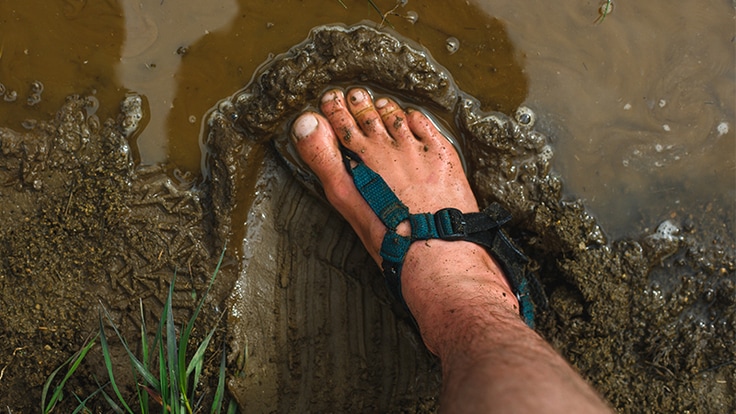




















![Z-Trail EV Sandals - Women's [Left view (Dusty Rose)]](/media/3e8a4fee-3767-4956-9fe8-79a5f5636bba/?size=440)

![Z-Trail EV Sandals - Women's [3/4 view (Dusty Rose)]](/media/bfe497d6-509f-442a-8a64-02dde1e0b805/?size=440)



![Arizona Rugged Sandals - Women's [Left view]](/media/85f0e3ed-afbf-4735-80e9-969d6737372c/?size=440)

